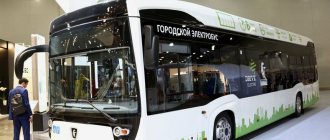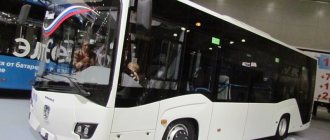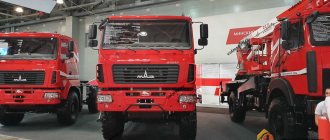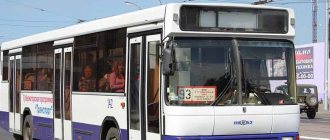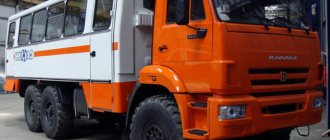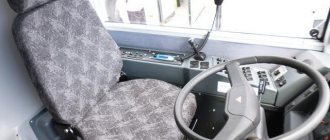Review of the city bus NEFAZ 5299-40-51
Details Category: Test drive Published 05/16/2015
In our reviews, we have already written more than once about cars and trucks. It's time to talk about buses. Meet: one of the latest novelties of KAMAZ OJSC - the NEFAZ 5299-40-51 low-floor city bus . It is also interesting for us because very soon such buses will begin to transport passengers along the roads of Naberezhnye Chelny.
For those who have never heard of NEFAZ buses , a little information. These are large class buses (10-12 m long), which are produced on the KAMAZ chassis. “NEFAZ” is also the name of a subsidiary of KAMAZ OJSC (Neftekamsk Bus Plant), which produces buses on the KAMAZ chassis.
It is located, no matter how difficult it may be to guess, in the city of Neftekamsk in the Republic of Bashkortostan.
The NEFAZ bus 5299-40-51 is one of the latest new products of the company. This is a 100% low-floor city bus. A low floor level is one of the main requirements for modern city buses. It allows passengers to conveniently board and disembark the bus without having to climb steps. The floor height in the NEFAZ 5299-40-51 bus is only 360 mm.
The bus also has a folding ramp at the middle door and a platform for placing a wheelchair in the cabin, equipped with a folding armrest and stop buttons, which allows you to transport passengers with disabilities.
The NEFAZ 5299-40-51 bus is equipped with a kniling system, which allows, by changing the pressure in the air suspension, to tilt the bus towards the stop, reducing the distance from the road to the floor of the bus, which makes it easier to board and disembark passengers.
The NEFAZ 5299-40-51 bus has a so-called improved interior. Compared to the previous version of the interior, the following changes are visible here:
- new, higher quality and pleasing-looking finishing materials
- new handles on the top rails
- new lampshades built into the ceiling
- new rounded ceiling panels (instead of the previous square boxes)
- more aesthetically pleasing trim of the engine compartment at the rear of the bus
In general, the interior of the bus itself is made more ergonomically: sharp corners and edges, screws sticking out everywhere, etc. are a thing of the past.
For comfort during the cold season, heaters are installed in the cabin. During the hot season, passengers have access to two hatches in the ceiling. They are equipped with an electric drive, the control buttons of which are located in the front part of the cabin.
The bus is designed to carry 24 seated passengers plus one wheelchair space. The total passenger capacity reaches 105 people.
The driver's cabin has also changed. Previously, the driver entered the workplace through one of the front door wings, and passengers through the second leaf. Now both doors provide free access directly to the bus interior. And already in the cabin, in the cabin partition, there is a swing door to the driver’s cabin.
This solution makes it easier for passengers to board and disembark, and also increases the free space for standing passengers. The door has a folding window with a niche for coins.
The door lock on the driver's side can be locked; for this there is a special lock on the opening handle.
The driver's workplace has become more comfortable. The cabin now has a large storage compartment behind the driver's seat, as well as numerous drawers and niches for small items.
The panoramic windshield and large rear-view mirrors provide excellent visibility behind the wheel.
But the salon mirror could be made not spherical, but rectangular and wider.
There are roll-down curtains on the side and windshield to protect the driver from the bright sun.
The bus is equipped with a Voith automatic transmission, so there are only two pedals on the floor - gas and brake.
Instead of the usual gearshift lever, there is a remote control with buttons.
It includes 5 buttons:
- D - forward movement
- R – reverse movement
- N – neutral
- 1, 2, 3 – buttons for selecting operating modes of the machine, depending on driving conditions
The gas pedal here is no longer floor-mounted, but suspended. To the left of the driver is the parking brake valve, as well as many buttons responsible for opening and closing doors, lighting and other functions.
Just above is the remote control for the automatic fire extinguishing system that this bus is equipped with.
The only negative that catches your eye is the archaic steering column switches on thin legs, familiar from Soviet trucks.
The instrument cluster is simple, includes an LCD display and 6 instruments:
- speedometer
- tachometer
- fuel level indicator
- coolant temperature
- two air pressure indicators (circuit I and circuit II)
The driver's seat itself is installed on an air cushion, providing comfort behind the wheel.
It has mechanical adjustments in several directions. The seat itself moves forward/backward on a slide over a fairly large range, which allows drivers of any size to sit comfortably.
The bus is made in the traditional design, which all NEFAZ buses after the latest restyling.
The difference from other versions is the presence of a block of gas cylinders on the roof, because it is equipped with a gas engine.
This bus also has a panoramic windshield (without a central partition), which improves visibility for the driver. Following the windshield, the wipers also changed: if on traditional versions the wipers in the parking position stand vertically at the central partition, then with panoramic glass they are located horizontally, at the lower edge of the glass.
Front optics of the NEFAZ bus from Hella. At the very bottom there are daytime running lights, which turn on after the engine starts. Above them, in three separate sections, there are low and high beams, as well as turn signals.
The bus has three double doors on the right side with electro-pneumatic control.
The heart of the NEFAZ 5299-40-51 bus is the six-cylinder gas engine Mercedes-Benz M 906 LAG. It complies with the Euro-5 environmental class and produces 279 hp. power and 1000 Nm of torque.
The fuel for it is methane gas. To store it, there are 8 gas cylinders on the roof of the bus, the total volume of which is 984 liters.
The engine is paired with a four-speed automatic transmission from Voith.
The front and rear suspension of the bus is pneumatic, the rear is dependent, the front is independent.
To achieve 100% low-floor axle, a portal-type rear axle is used, in which the main gear is located not in the center, but on the side. The main gear here is made in Italy, by Oerlikon Graziano.
It is precisely because of the installation of the portal bridge that the engine is not located in the center, but is shifted to the left.
All bus wheels have disc brakes.
Where are they made and released? Who is the manufacturer?
The production of equipment under the NefAZ brand is carried out by the Neftekamsk Automobile Plant (abbreviated NefAZ), located in the Republic of Bashkortostan, the city of Neftekamsk . The plant is part of the structure of KamAZ PJSC. Bus production has been carried out since 2000. In addition to passenger transport, the company's model line includes the following categories of vehicles: crew buses, dump trucks, tank cars, trailers and semi-trailers, fire fighting and agricultural equipment.
Model specifications
Technical characteristics of buses are important when choosing and purchasing transport. Potential clients carefully study and analyze the parameters in order to purchase a model with optimal properties to solve their problems.
What is the factory standard?
NefAZ-5299-11-56, suburb, gas. Photo Transport Center
In order to achieve the production of buses with technical characteristics presented at a high level, the company adheres to the following principles :
- maximum satisfaction of customer needs is achieved through the provision of high quality equipment in a wide range;
- the use of innovations and reliable mechanisms and components from leading foreign and Russian companies guarantees high operational safety;
- The efficiency of one bus model performing a wide range of tasks is achieved through the introduction of expanded functionality.
Characteristics
There are a significant number of characteristics according to which the classification is carried out, and the maximum, minimum, and average values for the entire model line are identified. All parameters can be divided into two groups: internal and external characteristics.
Outside
Bus NefAZ-4299-30-52. Photo NefAZ
External parameters include:
- overall dimensions : length x width x height, average figures are 10100 x 2525 x 3000;
- curb and technically permissible weight, 11000 and 18000;
- cabin capacity , 35 seats and total capacity - 100;
- the seating layout differs depending on the number of seats, the purpose of the model, and the number of additional options;
- characteristics, features and advantages of the driver's seat and instrument panel;
- tire size , popular indicators are 215/75R17.5 and 275/70 R22.5.
More detailed information is provided in a separate article.
Inside
Shift bus 42111-0000013-45. Photo NefAZ
Internal characteristics include:
- engine : brand/manufacturer (Cummins, Weichai, Yuchai, Mercedes-Benz), country of manufacture (PRC, Germany, USA), type of power unit (diesel, gas), compliance with environmental standards (Euro-3-Euro-5), operating volume (the average is about 7.5 liters), power (200 hp), location (in the front or rear of the structure), number and arrangement of cylinders (6V, 6R);
- engine cooling system , most often in models - liquid;
- gearbox : brand/manufacturer (KAMAZ, ZF, Fast Gear, Voith, Allison), country of manufacture (Germany, USA), type (mechanical or automatic), number of feet (7-8);
- brake system : brand/manufacturer (Knorr-Bremse, Wabco), country of manufacture (Germany, USA), type of mechanisms (disc or drum);
- fuel type : diesel, gas, electric energy;
- fuel tank volume, average is 350 liters;
- fuel consumption per 100 km, 35 liters;
- The power reserve depends on the volume of the tank and fuel consumption, and varies significantly.
Other information and a more detailed discussion of the parameters are collected in the corresponding publication.
Comparison with other domestic companies in the table
There is little competition among Russian manufacturers in the domestic market. It is possible to put . The table below presents a comparative analysis of the two companies.
Reference. Not all types of models are constantly available in the assortment; it is recommended to monitor the updating and replenishment of the model range on the official website of the manufacturers.
| Parameter | NefAZ | GAS |
| Date of foundation, year | 1972 | 2005 |
| Market share, % | 4 | 80 |
| Model line | General buses: city, suburban, intercity, tourist and special purpose: rotational, school, platform. Models powered by diesel, methane, electric energy. Equipment of small, medium, large and especially large capacity classes. | General buses: city, suburban, intercity, tourist and special purpose: school, ritual, cargo-passenger. Cars of small, medium, large and especially large capacity. Equipment operating on gasoline, diesel, gas, electricity. |
| Trade marks | NefAZ, KamAZ | PAZ, LiAZ, KavZ, GAZ |
| Advantages of buses | a significant number of modifications of each of the few models; affordable price; application of innovative technologies; ease of ownership, operation and maintenance; use of high-quality and reliable components; compliance with current environmental standards; ensuring comfort for passengers of various categories; an extensive list of additional services. | rich model range, a significant number of models and modifications; improved consumer and technical characteristics; compliance with international standards; modern interior and exterior design; low operating costs; competitive price in comparison with foreign analogues; unification of models; wide dealer network; large selection of options; an extensive list of additional services. |
Description of the history of the company's development. How did KamAZ create its models?
In the 1970s, the construction of the KamAZ plant was carried out. The government decided to build satellite factories specializing in the supply of necessary components to KamAZ. NefAZ became one of these satellite plants. in the summer of 1972. Five years later, the main conveyor was launched and mass production of dump trucks began. The first stage of production of rotational buses dates back to 1981. In 1993, the company was renamed OJSC Neftekamsk Automobile Plant.
Suburban bus NefAZ-5299-11. Photo Wikipedia
In 2000, the development of a large-capacity urban model began and at the end of the year the NefAZ-5299 bus was presented. In the mid-2000s, together with the VDL concern, NefAZ assembled new buses for passenger transportation for various purposes - VDL-NefAZ. However, the equipment never went into mass production. In 2012, the KamAZ-Marko joint venture began manufacturing Bravis buses. In 2016 – renaming from OJSC NefAZ to PJSC NefAZ. In 2022, a joint development of plants from Neftekamsk and Naberezhnye Chelny will be presented - the KamAZ-6282 electric bus.
KamAZ-6282
KamAZ-6282 is the first serial Russian electric bus jointly developed by NefAZ and KamAZ. This is a completely low-floor electric bus designed for urban environments. It uses the main components of traction electrical equipment, including an electric portal bridge and lithium-titanate batteries with an energy capacity of 80 kW with a maximum range of 70 km. Moreover, the battery life is up to 20,000 cycles. The bus is equipped with 3 doors and can accommodate up to 85 passengers. The cabin has 33 plastic, comfortable seats, a ramp and…
- Further -
Small class buses, Large buses, City buses, Rear engine, NEFAZ, Low floor buses, Single buses, Extra large buses, Front engine buses, Articulated buses
Where are they sold?
Thus, the Neftekamsk Automobile Plant develops, produces and sells buses to solve a wide range of problems. The variety of technical characteristics and models of equipment, the affordable cost of transport and its operation provides buyers of all types (individuals and legal entities, individual entrepreneurs, non-profit organizations) with a wide choice. You can buy NefAZ buses directly from the manufacturer or from employees of supplier companies. Some companies are presented in the corresponding section of our website. The enterprises also provide related ]rental[/anchor], leasing and re-equipment services.
All-terrain buses, Small buses, Shift buses, High-floor buses, NEFAZ, Single buses, Special buses
Plant emblem based on KamAZ
The emblem acquired its current appearance in 2016. Previously, the logo consisted of the inscription “NEFAZ NEFTEKAMSKY AUTO PLANT” in two lines, in printed capital letters. The letter “F” was two semicircles connected by a transverse line. In 2016, a branding agency from Moscow developed a new visual image.
NefAZ logo. Photo Wikipedia
The logo combines the name of the company in Latin - NEFAZ - and an inclined, more voluminous letter “H” in the shape of an arrow-pointer. Tilt creates a feeling of speed, dynamics, movement . The promotion company helped the company find a new identity - modern, but at the same time reminiscent of the plant’s rich history. The font used is close in style to the typography of Soviet industrial posters.
